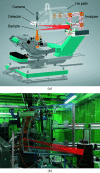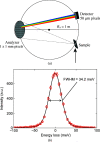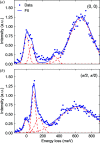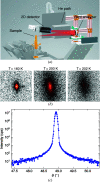Resonant inelastic X-ray scattering endstation at the 1C beamline of Pohang Light Source II
- PMID: 36947164
- PMCID: PMC10161893
- DOI: 10.1107/S1600577523001625
Resonant inelastic X-ray scattering endstation at the 1C beamline of Pohang Light Source II
Abstract
An endstation for resonant inelastic X-ray scattering (RIXS), dedicated to operations in the hard X-ray regime, has been constructed at the 1C beamline of Pohang Light Source II. At the Ir L3-edge, a total energy resolution of 34.2 meV was achieved, close to the theoretical estimation of 34.0 meV, which considers factors such as the incident energy bandpass, intrinsic analyzer resolution, geometrical broadening of the spectrometer, finite beam-size effect and Johann aberration. The performance of the RIXS instrument is demonstrated by measuring the RIXS spectra of Sr2IrO4. The endstation can be easily reconfigured to measure energy-integrated intensities with very low background for diffuse scattering and diffraction experiments.
Keywords: 1C beamline; PLS-II; RIXS spectrometer; hard X-rays; resonant inelastic X-ray scattering.
open access.
Figures






References
-
- Ament, L. J. P., Khaliullin, G. & van den Brink, J. (2011b). Phys. Rev. B, 84, 020403.
-
- Ament, L. J. P., van Veenendaal, M., Devereaux, T. P., Hill, J. P. & van den Brink, J. (2011a). Rev. Mod. Phys. 83, 705–767.
-
- Bertinshaw, J., Kim, J. K., Porras, J., Ueda, K., Sung, N. H., Efimenko, A., Bombardi, A., Kim, J., Keimer, B. & Kim, B. J. (2020). Phys. Rev. B, 101, 094428.
-
- Braicovich, L., Ament, L. J. P., Bisogni, V., Forte, F., Aruta, C., Balestrino, G., Brookes, N. B., De Luca, G. M., Medaglia, P. G., Granozio, F. M., Radovic, M., Salluzzo, M., van den Brink, J. & Ghiringhelli, G. (2009). Phys. Rev. Lett. 102, 167401. - PubMed
-
- Gao, X., Casa, D., Kim, J., Gog, T., Li, C. & Burns, C. (2016). Rev. Sci. Instrum. 87, 083107. - PubMed
Grants and funding
LinkOut - more resources
Full Text Sources
Research Materials

